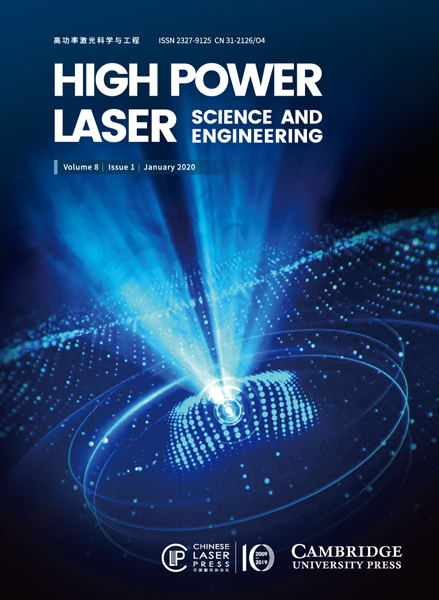2015, 3(3) Column
High Power Laser Science and Engineering 第3卷 第3期
The status of the European X-ray Free-Electron Laser (European XFEL), under construction near Hamburg, Germany, is described. The start of operations of the LCLS at SLAC and of SACLA in Japan has already produced impressive scientific results. The European XFEL facility is powered by a 17.5 GeV superconducting linear accelerator that, compared to these two operating facilities, will generate two orders of magnitude more pulses per second, up to 27 000. It can therefore support modes of operation switching the beam up to 30 times per second among three different experiments, providing each of them with thousands of pulses per second. The scientific possibilities opened up by these capabilities are briefly described, together with the current instrumental developments (in optics, detectors, lasers, etc.) that are necessary to implement this program.
femtosecond lasers and applications femtosecond lasers and applications free-electron lasers and applications free-electron lasers and applications repetition frequency technology repetition frequency technology Self-emission x-ray shadowgraphy provides a method to measure the ablation-front trajectory and low-mode nonuniformity of a target imploded by directly illuminating a fusion capsule with laser beams. The technique uses time-resolved images of soft x-rays (>1 keV) emitted from the coronal plasma of the target imaged onto an x-ray framing camera to determine the position of the ablation front. Methods used to accurately measure the ablation-front radius (δR=±1.15 μm), image-to-image timing (δ(Δt)=±2.5 ps) and absolute timing (δt=±10 ps) are presented. Angular averaging of the images provides an average radius measurement of δ(Rav=±0.15 μm and an error in velocity of δV/V= ±3%. This technique was applied on the Omega Laser Facility [Boehly et al., Opt. Commun. 133, 495 (1997)] and the National Ignition Facility [Campbell and Hogan, Plasma Phys. Control. Fusion 41, B39 (1999)].
low mode nonuiformity low mode nonuiformity nuclear fusion nuclear fusion self-emission shadowgraphy self-emission shadowgraphy shell trajectory shell trajectory FLASH at DESY, Hamburg, Germany is the first free-electron laser (FEL) operating in the extreme ultraviolet (EUV) and soft x-ray wavelength range. FLASH is a user facility providing femtosecond short pulses with an unprecedented peak and average brilliance, opening new scientific opportunities in many disciplines. The first call for user experiments has been launched in 2005. The FLASH linear accelerator is based on TESLA superconducting technology, providing several thousands of photon pulses per second to user experiments. Probing femtosecond-scale dynamics in atomic and molecular reactions using, for instance, a combination of x-ray and optical pulses in a pump and probe arrangement, as well as single-shot diffraction imaging of biological objects and molecules, are typical experiments performed at the facility. We give an overview of the FLASH facility, and describe the basic principles of the accelerator. Recently, FLASH has been extended by a second undulator beamline (FLASH2) operated in parallel to the first beamline, extending the capacity of the facility by a factor of two.
bunch compression bunch compression free-electron laser free-electron laser high-gain FEL process high-gain FEL process photo injector photo injector SASE SASE superconducting accelerator superconducting accelerator undulator undulator For the success of PAL-XFEL, two critical systems, namely a low emittance injector and a variable gap out-vacuum undulator, are under development. In order to realize the target emittance of the PAL-XFEL injector we carried out an optimization study of various parameters, such as the laser beam transverse profile, the laser pulse length, the laser phase, and the gun energy. The transverse emittance measured at the Injector Test Facility (ITF) is εx=0.48±0.01 mm mrad. An undulator prototype based on the EU-XFEL design and modified for PAL-XFEL was built and tested. A local-K pole tuning procedure was developed and tested. A significant reduction (90%) of the local-K fluctuation was observed. The requirement of undulator field reproducibility better than 2 ×104 and the undulator gap setting accuracy below 1 μm were achieved for the prototype. The optical phase jitter after the pole height tuning at the tuning gap was calculated to be 2:6_ rms, which satisfies the requirement of 5.0_.
emittance emittance free-electron lasers (FELs) free-electron lasers (FELs) photocathode RF-gun photocathode RF-gun undulator undulator Velocity Interferometer System for Any Reflector (VISAR) [Barker and Hollenbach, J. Appl. Phys. 43, 4669 (1972)] is a well-known diagnostic that is employed on many shock physics and pulsed-power experiments. With the VISAR diagnostic, the velocity on the surface of any metal flyer can be found. For most experiments employing VISAR, either a kinetic pressure [Grady, Mech. Mater. 29, 181 (1998)] or a magnetic pressure [Lemke et al., Intl J. Impact Eng. 38, 480 (2011)] drives the motion of the flyer. Moreover, reliable prediction of the time-dependent pressure is often a critical component to understanding the physics of these experiments. Although VISAR can provide a precise measurement of a flyer’s surface velocity, the real challenge of this diagnostic implementation is using this velocity to unfold the timedependent pressure. The purpose of this paper is to elucidate a new method for quickly and reliably unfolding VISAR data.
laser driven blast wave laser driven blast wave pulsed-power pulsed-power VISAR VISAR Temperature and density asymmetry diagnosis is critical to advance inertial confinement fusion (ICF) science. A multimonochromatic x-ray imager, MMI, records the spectral signature from an ICF implosion core with time resolution, 2D spatial resolution and spectral resolution. While narrow-band images and 2D space-resolved spectra from the MMI data constrain the temperature and the density spatial structure of the core, the accuracy of the images and the spectra highly depends on the quality of the MMI data and the processing tools. Here, we synthetically investigate the criterion for reliable MMI diagnostics and its effects on the accuracy of the reconstructed images. The pinhole array tilt determines the object spatial sampling efficiency and the minimum reconstruction width, w. When the spectral width associated with w is significantly narrower than the spectral linewidth, the line images reconstructed from the MMI data become reliable. The MMI setup has to be optimized for every application to meet this criterion for reliable ICF diagnostics.
high power laser high power laser inertial confinement fusion inertial confinement fusion monochromatic imager monochromatic imager x-ray diagnostics x-ray diagnostics An all-solid-state single-frequency 1064 nm laser with a 100 μs pulse width, 500 Hz repetition rate and 700 mJ single pulse energy is designed using seed injection and a three-stage master oscillator power amplifier (MOPA) construction. Using this as a basis, research on long-pulse laser frequency doubling is carried out. By designing and optimizing the lithium triborate (LBO) crystal, the theoretically calculated maximum conversion efficiency _max reaches 68% at M2=1, while _min is 33% at M2=3. Generation of 212 mJ pulses of green light with a repetition rate as high as 500 Hz is obtained from a fundamental energy of 700 mJ. The experimental conversion efficiency reaches 31% and the power stability is better than ±1%.
all-solid-state all-solid-state frequency doubling frequency doubling MOPA construction MOPA construction single-frequency laser single-frequency laser A high-power narrow-linewidth 1018 nm fiber laser based on a single-mode–few-mode–single-mode structure Download:883次
Download:883次
 Download:883次
Download:883次We demonstrate an all-fiber high-power Yb-doped 1018 nm fiber laser with a Gaussian-shaped output beam profile based on a mismatched structure, which consists of a pair of single-mode fiber Bragg gratings and a section of few-mode double-cladding gain fiber. The output power is up to 107.5W with an optical-to-optical efficiency of 63%, and the 3 dB band is 0.26 nm at this power level. Such a structure of single-mode–few-mode–single-mode fiber oscillator can be used to generate high-power narrow-linewidth lasing with excellent beam quality in other spectral ranges.
fiber laser fiber laser 1018 nm laser 1018 nm laser In this paper we review the provision of the laser diagnostics that are installed on the Vulcan laser facility. We will present strategies for dealing with the energy of high energy systems and with ways of handling the beam sizes of the lasers. We present data captured during typical experimental campaigns to demonstrate their reliability and variation in shot to shot values.
calorimeter calorimeter high power laser high power laser laser diagnostics laser diagnostics pulse energy pulse energy 动态信息
动态信息 丨 2023-06-21
HPL Highlight (Vol. 11, e40): NIF仍然是全球唯一一个能够进行ICF点火实验的装置动态信息 丨 2023-06-21
HPL Highlight (Vol. 11, e9): 变分神经网络预测激光尾波场加速电子能谱动态信息 丨 2023-06-21
HPL Highlight (Vol. 11, e7): 目标探测网络加入,激光等离子体加速器实现实时诊断动态信息 丨 2023-06-21
HPL Highlight (Vol. 11, e5): 910 nm波段超宽带种子源,向100 PW超强超短激光进发动态信息 丨 2023-06-21
HPL Highlight (Vol. 11, e4): 100 PW单束压缩!多步压缩器进阶双光栅激光评论微信公众号

点击菜单“联系编辑”即可添加期刊编辑为好友啦




